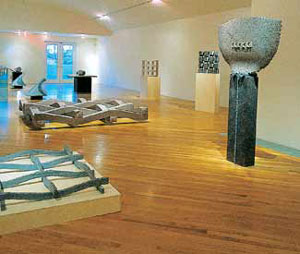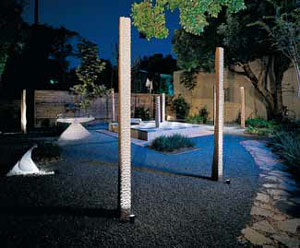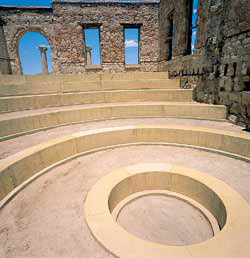Jesús Bautista Moroles
With 13 one-man shows this year and counting, this Texas sculptor is constantly on the move
By Bonnie Gangelhoff, SOUTHWEST ART

Installation at Cline LewAllen Contemporary, Santa Fe, NM, 1995.
In the spring of 1980, sculptor Jesús Bautista Moroles was trekking up a mountainside in Italy when he found his artistic way. Under his feet lay a footpath, a carpet of grass dotted with marble steps. The steps bore a worn patina, polished by centuries of feet padding over the stone, often by men bound for work in the quarries.
“Walking up the steps, I thought, ‘that’s what I want. I want my art to be about man touching stone, but with nature all around it,’” Moroles says. For the young Texas sculptor, the journey to the Italian villages of Pietrasanta and Carrara carried a spiritual connection, too. One of his heroes, the Renaissance artist Michelangelo, had traversed the same mountain trails, foraging for the stone he would use in his grand sculptures.
Today, viewers perceive a similar element in the art of Michelangelo and Moroles—mainly their use of virile sculptural forms. But unlike the great master, Moroles works only in granite, and he makes his pilgrimages to the pink- and red-granite quarries near Fredericksburg, Llano, and Marble Falls in the picturesque Texas Hill Country.
What distinguishes Moroles from many modern sculptors is his refusal to carve the granite once he has hauled it from the quarries. He believes that carving mutilates the crystals buried inside the stone. Instead, Moroles “tears” granite, a process wherein he hammers five-inch steel wedges into the stone, causing it to split along the natural grain and erupt with a primordial sound.
“When the granite tears, you can hear it coming. You hear this crackling getting faster and faster, and it races through the stone in a big rush. It’s like a mini-explosion that hits you right in the center of your being,” Moroles says.
Except for public commissions, the sculptor uses no sketches, preferring to let his work evolve. He polishes some surfaces of the granite while leaving others rough, the way they are found in nature. The interplay of the smooth and rough surfaces has become a vital element in his artistic vocabulary, a rendition of the man-and-nature theme he envisioned in the mountains of Italy more than a decade ago.

Installation of selected works, Robert McClain & Co. sculpture garden, Houston, TX, 1996. Foreground: Two Sky Diamondback Totems, 1996, Fredericksburg granite, h 111.
Since Moroles’ return from Italy in 1980 he has worked feverishly, exhibiting in more than 200 galleries and museums across the country. He was included in the landmark 1987 traveling museum exhibition Contemporary Hispanic Art in the United States, and has work in many museum collections. So far this year, he has had 13 solo shows, including a one-year installation at the Museum of Outdoor Art in Denver, CO. On September 18 he will be in New York, NY, for the opening of his show at J. Cacciola Gallery, which includes a new outdoor sculpture garden complete with fountains and benches.
To date, Moroles’ largest work is a 1991 memorial to Houston police officers, a 120-by-120-foot public sculpture on the banks of Buffalo Bayou. His most visible, however, is Lapstrake, a 64-ton, 22-foot-tall sculpture at the E.F. Hutton CBS Plaza in New York, NY, across the street from the Museum of Modern Art.
In 1983, Moroles settled in Rockport, a small fishing village and art community on the Texas Gulf Coast, a speck on the map sprinkled with tackle-and-bait joints and cozy cafes that serve up catfish and soft-shell crabs. “I went to where I remembered growing up, where I could have seafood and water and the Gulf of Mexico … where I could work outside on my monumental pieces year round,” he says. Moroles chose a locale where he fished as a young boy and where he also worked for his uncle, a stonemason.
Moroles was born in 1950 about 25 miles south of Rockport in Corpus Christi, TX. He is the oldest of six children born to Jose and Maria Moroles. His beginnings were hardscrabble and humble: His father swept floors for an optical company for a living while his mother picked cotton. She often brought baby Jesús to the fields with her, placing him under the wagon where the cotton was weighed to shield him from the blistering Texas sun. “They called me the baby of the cotton fields,” Moroles says.
Moroles’ passion for art came early—by the third grade, he knew he wanted to be an artist. In fourth grade he began painting classes at the YMCA, and by 13 he was doing commissions from photographs for people’s living rooms. In high school he ran a thriving silk-screen business. Then the Vietnam War intervened, and he spent four years in the Air Force.
Two years later, Moroles enrolled at North Texas State University, where sculpture class captured his imagination. Sculpting granite held similar allure because it felt the most like hard labor. He met sculptor Luis Jimenez there and signed on as his apprentice. Jimenez was working in fiberglass and Moroles in stone, but “everything translated.” He managed to stash away enough money to fulfill his burning desire to work in Italy for a year. In 1979 he arrived in Pietrasanta, a northern Italian stone center that attracts artists from all over the world.

Completed tabletop sculptures at the Moroles studio in Rockport, TX. Photo by Ann C. Sherman.
One Houston art dealer still remembers the day in 1981 that Moroles first appeared at his gallery. “He had just returned from Italy and was driving a little pickup truck with two pieces of sculpture and some hand tools in the back,” says Robert McClain, who still represents the sculptor in Houston, along with his former partner, Barbara Davis. “He told us he was going to build the premier factory in the country for making granite sculpture. Jesús had such drive in his eyes that we believed him.”
Within a few years, Moroles had purchased property in Rockport, where he eventually built a cavernous, 22,000-square-foot studio/factory. While many sculptors farm out their sketches to manufacturers for execution, Moroles completes all his work in the factory, which rivals any in the world for the making of large-scale sculpture. He employs 15 to 24 full-time workers.
Granite, which is one of the hardest stones, requires great physical strength and perseverance. The creative process for Moroles involves shaping this tough material, often with diamond saws and hammers, until satisfying forms begin to emerge. His forms are universal columns, crescents, triangles, obelisks, and pyramids.
Water is a favorite component in Moroles’ artistic vocabulary. A perfect example is Granite Garden, an environment at the Birmingham Botanical Gardens, AL, which combines 45 sculptural and fountain elements.
What is intriguing about Mor-oles’ work is that it radiates so many paradoxes. It evokes both ancient and modern civilizations. Sensuous columns resemble both pre-historic totems and sleek, towering skyscrapers. A mammoth thousand-pound sculpture like Granite Weaving Playscape manages to appear delicate, almost fragile. When Moroles is in Rockport, he lives in a small apartment attached to the factory. His parents live about 100 yards away and, in the tradition of close-knit Hispanic families, the factory/studio is a family affair. Sister Susanna juggles schedules, openings, and paperwork. Brother Hilario heads up transportation and installations. Father Jose has transformed the Moroles compound into a lush tropical paradise of banana trees, vine-covered arches, and stalks of brilliant orange birds of paradise. A colorful menagerie of peacocks, doves, and cockatoos nest on the grounds, looked after by his mother.

The amphitheater at the Moroles compound in Cerrillos, NM. Photo by Ann C. Sherman.
Moroles doesn’t have many free moments, but when he does, he might stroll down to the water with a fishing pole on his shoulder. Or he might slip in a trip to Cerrillos, south of Santa Fe, where 13 years ago he purchased an old school and transformed it into the Cerrillos Cultural Arts Center (C3). The gymnasium and grounds are used for exhibitions in June he organized Spain in Cerrillos, with works by artists he encountered on a recent trip to Spain, where he is in the process of setting up a studio on the Costa Brava, about 30 miles north of Barcelona.
Someday, Moroles would like to view the Egyptian pyramids and Machu Picchu or other far-flung wonders that people say they ponder when they see his sculpture. But not now. There are too many mountains to scale at home.
“There is so much I want to accomplish, I wish I had been a pharaoh,” Moroles says. “With them, anything was possible. I have too many ideas for one lifetime.”
Photos courtesy Barbara Davis Gallery, Houston, TX; Robert McClain & Co., Houston, TX; Cline LewAllen Contemporary, Santa Fe, NM; and J. Cacciola Gallery, NY, NY.
Bonnie Gangelhoff is a Houston-based freelance writer.
